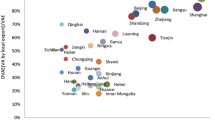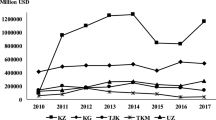Abstract
Through an analysis of the effects of Guangdong on exports from other provinces, this paper examines China’s interregional relationships regarding exports. We utilize provincial level data from 1998 to 2008 and apply the system GMM to estimate an empirical model derived from the gravity equation. The results indicate that Guangdong significantly crowds out exports from other provinces. Coastal provinces are less affected than their non-coastal counterparts. In coastal areas, the displacement effect on the Yangtze River Delta is less than that on the Pan Bohai Rim. Further research reveals that the improvements in service industries, labor productivity, capital-labor ratio, and agglomeration of manufacturing industries have significantly reduced export competition. Additionally, a province with a larger market potential or a lower degree of market disintegration is less affected by Guangdong’s export competition.
Similar content being viewed by others
Notes
These nine countries are big economies and leading importers in the world. More importantly, these countries are China’s major trading partners. In addition, during the whole sample period, China’s position in the imports of these nine countries has been enhanced all the way.
The nearest port to Hebei is Tianjin rather than Qinhuangdao, and the nearest port to Jiangsu is Shanghai rather than Lianyungang. Using Qinhuangdao and Lianyungang as the respective ports of Hebei and Jiangsu makes no difference.
Besides Guangdong, coastal regions include the Pan Bohai Rim (Beijing, Tianjin, Hebei, Liaoning, and Shandong), the Yangtze River Delta (Jiangsu, Zhejiang, and Shanghai) and Fujian, Guangxi, and Hainan.
Although Hebei is in the Pan Bohai Rim, its export-GDP ratio is only 8 % during 1998–2008.
The author is grateful to Haojie Shan at Shenyin & Wanguo Securities for data of provincial capital stock (Shan 2008, pp. 17–32). Labor in capital-labor ratio refers to the employed population at the end of the year.
Take average wage for example, Shanghai, Beijing, Zhejiang, Tianjin, and Jiangsu rank the top five, with scores of 1, 2, 3, 4, and 5 respectively.
The distance within a province is 2/3 of its geographic radius: D jj =\( 2/3 \cdot \sqrt {Area_{j} /\pi } \), and the area is the land area of a province (Reading and Venables 2004, pp. 53–82).
References
Arellano, M., and S. Bond. 1991. Some tests of specification for panel data: Monte Carlo evidence and an application to employment equations. Review of Economic Studies 58(2): 277–297.
Arellano, M., and O. Bover. 1995. Another look at the instrumental variables estimation of Error-Components models. Journal of econometrics 68(1): 29–51.
Bai, C., Y. Du, Z. Tao, and Y. Quan. 2004. Local protectionism and industrial concentration in China: overall trend and important factors. Economic Research Journal 4: 29–40. (in Chinese).
Bergstrand, J.H. 1985. The gravity equation in international trade: some microeconomic foundations and empirical evidence. Review of Economics and Statistics 67(3): 474–481.
Blundell, R., and S. Bond. 1998. Initial conditions and moment restrictions in dynamic panel data models. Journal of econometrics 87(1): 115–143.
Chen, X., and Y. Xu. 2008. Changes in the spatial structure of China manufacturing industries and its influence on regional specialization. Economic Research Journal 10: 104–116. (in Chinese).
Feenstra, R.C., J.R. Markusen, and A.K. Rose. 2001. Using the gravity equation to differentiate among alternative theories of trade. Canadian journal of economics 34(2): 430–447.
Harris, C.D. 1954. The market as a factor in the localization of industry in the United States. Annals of the Association of American Geographers 44(4): 315–348.
Jin, H., Y. Qian, and B. Weingast. 2005. Regional decentralization and fiscal incentives: federalism, Chinese style. Journal of public economics 89(9-10): 1719–1742.
Lu, M., and Z. Chen. 2009. Fragmented growth: why economic opening may worsen domestic market segmentation. Economic Research Journal 3: 42–52. (in Chinese).
Pan, W., and Z. Li. 2007. Feedback and spillover effects between coastal and non-coastal regions in China. Economic Research Journal 5: 68–77. (in Chinese).
Poncet, S. 2003. Measuring China’s domestic and international integration. China economic review 14(1): 1–21.
Qian, Y., G. Roland, and C. Xu. 1999. Why China is different from Eastern Europe? Perspectives from organization theory. European Economic Review 43(4–6): 1085–1094.
Redding, S., and A.J. Venables. 2004. Economic geography and international inequality. Journal of International Economics 62(1): 53–82.
Roodman, D. 2009. How to do xtabond2: an introduction to difference and system GMM in stata. The stata journal 9(1): 86–136.
Shan, H. 2008. Reestimating the capital stock in China: 1952–2006. Journal of quantitative and technical economics 10: 17–32. (in Chinese).
Xu, X. 2002. Have the Chinese provinces become integrated under reform? China economic review 13(2–3): 116–133.
Young, A. 2000. The razor’s edge: distortions and incremental reform of the People’s Republic of China. Quarterly Journal of Economics 115(4): 1091–1135.
Zhang, X. 2006. Fiscal decentralization and political centralization in China: Implications for regional inequality. Journal of comparative economics 34(4): 713–726.
Zhang, J., T. Zhang, and T. Huang. 2010. Does domestic market segmentation push firms’ exporting. Economic Research Journal 8: 29–41. (in Chinese).
Zhu, X., X. Jin, and D. Luo. 2005. Market segmentation and the expansion of China’s export. Economic Research Journal 12: 68–76. (in Chinese).
Acknowledgments
The authors are grateful to two anonymous referees for their suggestions. The authors are also grateful to Zhao Chen, Dazhong Cheng, Min Hua, Jiuli Huang, Ming Lu, Haojie Shan, Suhua Tian, Xiangshuo Yin, Tangjun Yuan, Jun Zhang, and Yuan Zhang for their comments. Changyuan Luo acknowledges financial support from National Program for Support of Top-notch Young Professionals, National Social Sciences Foundation (11CJL039), Shanghai Pujiang Program (12PJC085), MOE Project of Key Research Institute of Humanities and Social Sciences at Universities (13JJD790004) and Project for Young Scholars of Fudan University. All remaining errors in this paper are solely their own.
Author information
Authors and Affiliations
Corresponding author
Rights and permissions
About this article
Cite this article
Zhi, Y., Luo, C. Export Competition in China: Evidence from Data at Provincial Level. Fudan J. Hum. Soc. Sci. 7, 621–638 (2014). https://doi.org/10.1007/s40647-014-0047-6
Received:
Accepted:
Published:
Issue Date:
DOI: https://doi.org/10.1007/s40647-014-0047-6




